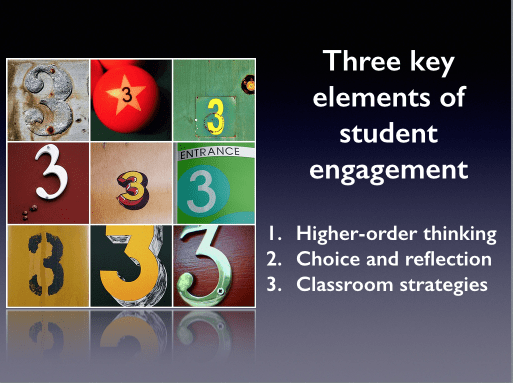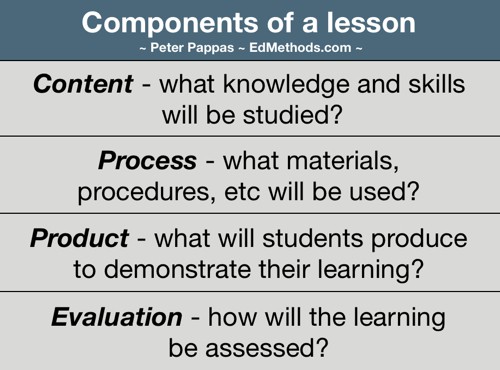
This week we consider two very different themes – social media and instructional design. The class begins by addressing key elements of lesson design :
- Higher-order thinking
- Student choice and reflection
- Effective classroom strategies
This portion of the class lesson includes three major elements:
- Practical examples of Bloom’s taxonomy in the form of sample exercises and questions. They are used to anchor a conversation on Bloom in action.
- How student choice can impact key lesson elements – content, process, product, evaluation.
- Demonstrate a student-centered approach to a teacher presentation as a way to foster reflection (instead of listening to a straight lecture on the subject)
The lesson is driven by a Keynote presentation. Handout (42MB pdf) We will use an audience response system to gather student input. The lesson includes multiple activities that illustrate the content. Student will be led through discussing their reactions to the activities to connect them to the content. This lesson will serve as a kick off to their first assignment to write and share a Lesson Study.
In the second half of the class we’ll meet in small groups to share our personal social media audits. We’ll be focusing on rolling out our new Google+ Community and learning how to use some it’s features. It’s a private group and will serve as an extension of classroom discussion through posts, comments, and Hangouts.
Assigned Readings for Class 3: None
Written assignment for Class 3:
Lesson Study I is due next week.
The goal of this assignment is two-fold. First to offer supportive feedback on your lesson development through a peer review process. Second to offer some “lenses to look through” that help you easily see the essentials of a lesson. It is not a substitute for the School of Education lesson plan format. Think of it as a pre-lesson plan planning guide. This is not some exercise for the benefit of your instructor. This should be a process that works for you. So feel free to modify to meet your particulars. Use a scale that works for you – focus on just a small segment of a larger unit, or look at the entire unit. Don’t like Bloom? Use another schema to discuss the kinds of thinking that your students will need to successfully complete the assignment. Assignment here. (383 KB pdf) Sample lesson study (378 KB pdf)
See results of this assignment in the first student posts


It’s always exciting to revisit Bloom’s Taxonomy when formulating lesson plans. Out of all the theory that has been present in my undergraduate experience, Bloom’s has always seemed to make the most sense when it comes to teaching for critical thinking and comprehension. While it’s easy to recall information from a session of note-taking/ lecture, the actual learning that is taking place is just recalling facts. To fully understand something, one must be able to ask questions of the information that they are learning as well as problem solve for these questions and evaluate/ interpret their findings. Overall, I believe that by practicing Bloom’s Taxonomy, one creates a more student-centered learning environment in which the students and the teacher are involved in higher level thinking and understanding. Being able to practice these theoretical concepts with the technology that is being incorporated in this course is really exciting!
I agree, Jenna. The higher order thinking concept keeps showing up in all our classes, as well as at the heart of the common core. While I think it’s amazing and inspiring, it is also at the same time so totally different than how I was taught in school, it’s hard for me to envision. I was great at giving the teacher the answer they were looking for. Looking forward to learning this stuff.
Hi Sam, I also find the concepts of common core and higher level thinking interesting because I wasn’t exposed to these ideas until college. I’m interested to see how student engagement changes when students have more ownership of the learning process and are asked to think at higher levels.
One of the easiest ways to make the transition from the way “you were taught” is to teach Bloom to students. (Or at least some sort of simplification of it between higher and lower order thinking). Imagine giving a prompt to the students and then adding “what kind of thinking does that require?” It would be so helpful to students to know if the task required (for instance) retrieving a fact, or developing an argument.
I really enjoyed reading and thinking about the components of a lesson. As a teacher, it is so important to reflect and evaluate what lessons and activities you are giving your students. We should focus on the key elements of lesson design higher-order thinking, student choice and reflection, and effective classroom strategies. Also, the box of components of a lesson and the questions that follow are a great resource for teachers who are planning anything from curriculum to a quick activity. We should constantly ask ourselves about the content, process, product, and evaluation to make sure our students are getting the most out of their education. We should also have a reason for each and every activity and lesson. I will definitely use these components and answer these questions whenever I am planning a lesson.